- How to Propagate Monstera Guide: The Three Ways to Succeed - September 17, 2021
- Escargot Begonia: Why Is The Rex Begonia So Rare? - August 31, 2021
- Rieger Begonia: When You Can Expect The Hiemalis Begonia To Flourish - August 31, 2021
This is a compact plant from the tropical regions of South America. This type of plant is perfect to display alongside other tropical plants or to use as an outdoor groundcover.
How to Identify Watermelon Peperomia
The key identifier for this plant is its leaves which look similar to the outside of a watermelon rind, hence its nickname.
How to Grow Watermelon Peperomia from Seed
These plants are more commonly propagated via leaf cuttings; however, it is still possible to grow one from seeds. To grow a Watermelon Peperomia from seed, follow these steps:
- Purchase seeds from a reputable seller (sellers who price their seeds between $1 and $2)
- Fill a container with a soilless seed starting mix
- Plant the seeds in the seed starting mix
- Water the mix so that it is moist but not soggy
- Place plastic wrap over the top of the container
- Set the container in a warm spot that gets plenty of bright, indirect sunlight
- Once sprouts appear, transplant the seeds to a container filled with soil that has a pH level between 6 to 6.5
How to Propagate Watermelon Peperomia
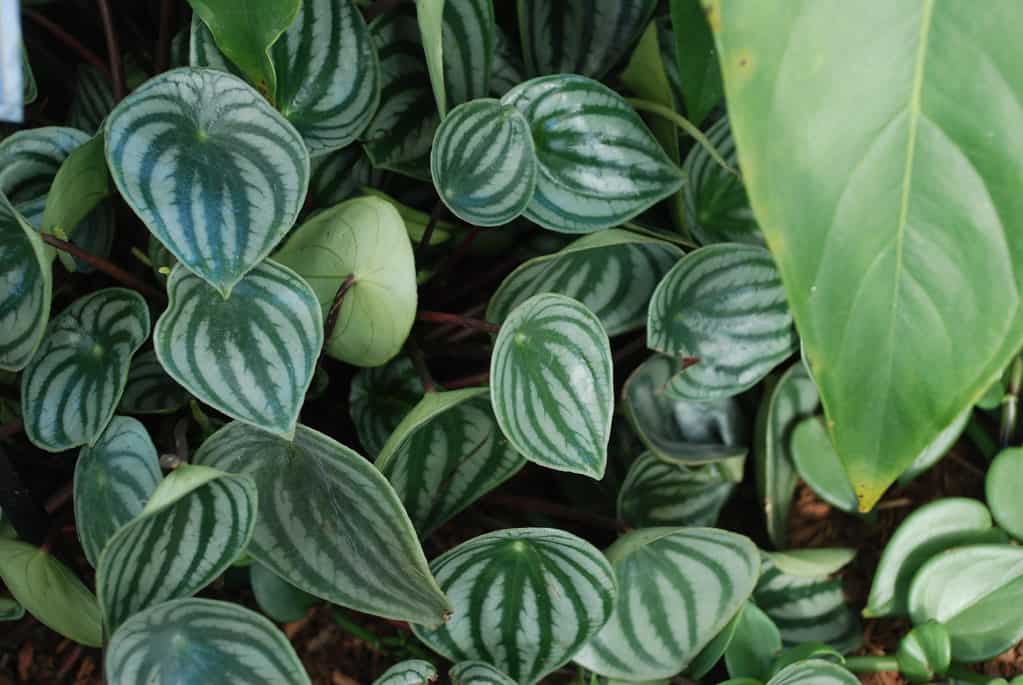
This plant is extremely easy to propagate via leaf cuttings. Here are the steps for growing a Watermelon Peperomia from a leaf cutting.
- Using a sterile cutting utensil, cut off a healthy leaf that includes a petiole
- Allow the leaves to callous for a day
- Dip the tip of the stem in a rooting hormone
- Fill a plant container with potting soil that is a half and half mix of peat and perlite soil
- Place the leaves four inches apart in the soil mix
- Press the stalks under the soil just slightly
- Moisten the soil with water
- Set the plant in a warm spot with bright, indirect sunlight
- Water the plant when the top inch of soil is dry
- Shoots should appear on the plant after a few weeks
Watermelon Peperomia Growing Conditions

Since it comes from a warm, humid climate it prefers growing in this type of environment. It will grow very well in temperatures that range between 65 and 75 degrees Fahrenheit and average humidity. If it does begin to look feeble, spray it with a water bottle or set a plant humidifier or pebble tray by it.
How to Plant Watermelon Peperomia
Since this plant enjoys being slightly potbound, it will not need to be repotted frequently; however, it is a good idea to replant it every few years to provide it with fresh and nutrient-rich soil. The steps for repotting a Watermelon Peperomia are:
- Fill a container with potting soil (if the plant has outgrown its current container, choose a new container that is two inches larger in diameter)
- Create a hole in the soil for the plant to set inside
- Carefully remove the plant from its current container
- Gently dust off any excess soil from its roots
- Set the plant into the hole in the new container
- Spread the soil around so that the plant is secure in its new container
- Water the plant
- Set it in a warm spot with indirect sunlight
Watermelon Peperomia Potting & Soil
This plant will grow best in potting soil that is made from 2 parts peat moss and 1 part perlite.
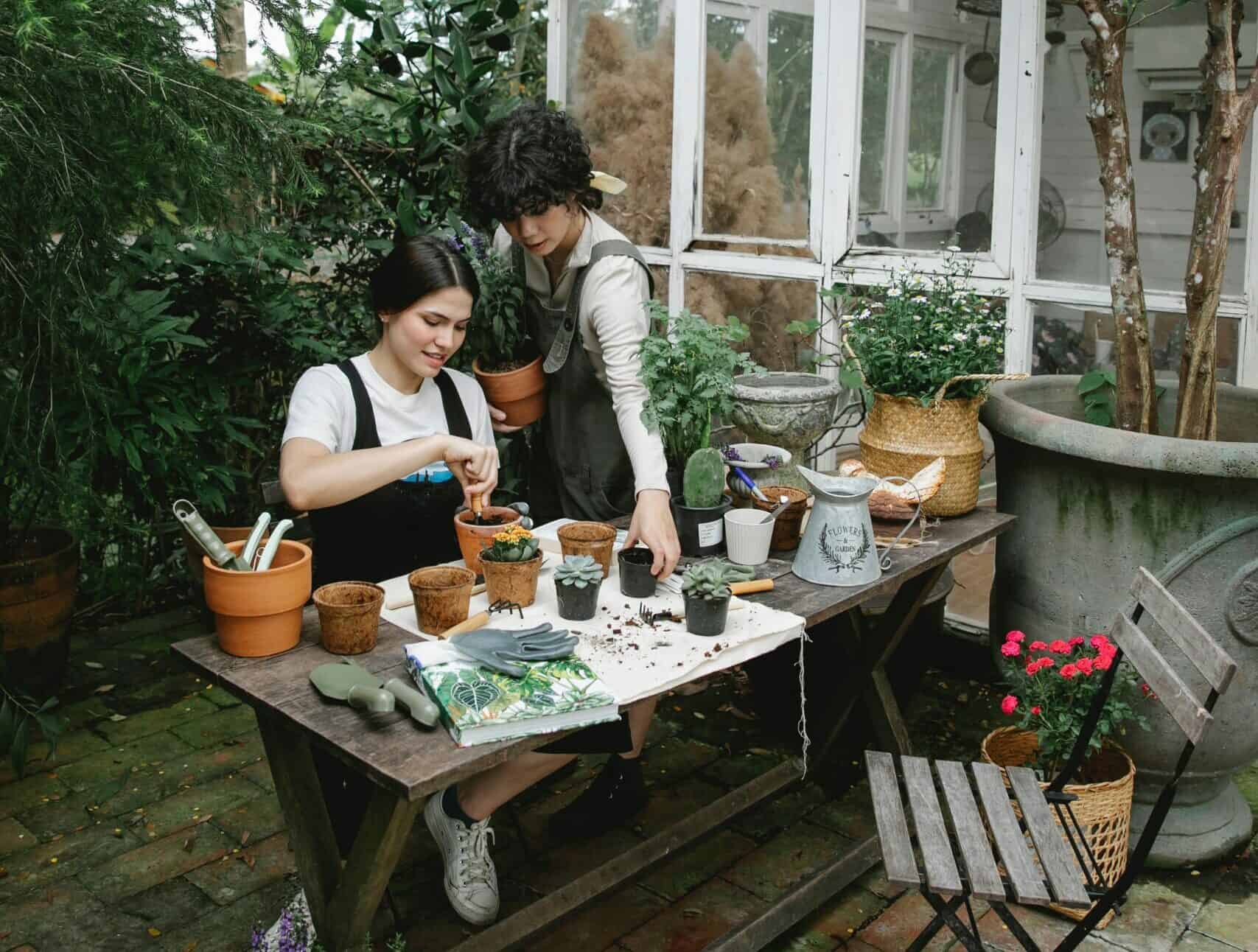
Watermelon Peperomia Water Requirements
It is important to water this plant correctly so that it doesn’t get root rot from overwatering or begin to wilt from under-watering. The best way to water Watermelon Peperomia is to use the soak and dry method. The steps for doing this are as follows:
- Test the soil moisture level before giving it a drink. If the top two inches of its soil is dry, it can use a drink, if however, the top two inches are still moist, it does not need any more water.
- If the plant needs a drink, fill a tray with a few inches of distilled water or rainwater.
- Set the plant container in the tray of water.
- Let the plant soak in the water for fifteen minutes. The roots will soak up water from the bottom of the container.
- Take the plant container out of the water.
- Allow the excess water to drain from the holes in the bottom of the plant container. If the soil mixture is done right, there should not be any soil coming out of the bottom with the excess water.
For peace of mind, try using a plant watering app to track when a plant has been watered, set reminders to water it, and get answers to common plant care questions.
Watermelon Peperomia Light Requirements
The most important thing to remember when selecting a spot for this plant is that it cannot handle full sun all day long. It is best to set Watermelon Peperomia in a location that gets plenty of bright sunlight that is either indirect or is filtered by a shade or curtain.
Try using a light meter to test indoor light capacity. This is a great way to ensure that the plant is receiving the amount of sunlight it needs.
Best Watermelon Peperomia Fertilizer
This plant should only be fertilized during spring and summer. Use a liquid fertilizer that has been diluted to feed it every 2 to 4 weeks during these seasons.
Best Watermelon Peperomia Companion Plantings
Since this is a tiny plant it can look a little lonely when set by itself. A few companion plants can solve this problem very quickly. The following three plants are just a sample of the many plants that would look wonderful as a companion to a Watermelon Peperomia plant.
Peperomia Hope
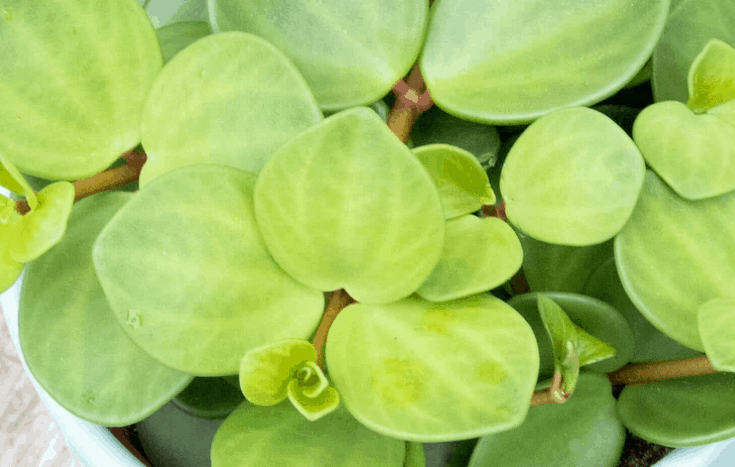
This plant also comes from the tropical regions of South America and shares many features and care requirements with Watermelon Peperomia.
Light Requirements
Peperomia Hope should be set in a place that receives plenty of bright but filtered or indirect sunlight.
Soil Requirements
Peperomia Hope requires soil that is well-draining, contains a 50/50 ratio of peat moss and perlite, and has a pH level that ranges between 6 and 6.5.
Water Requirements
Peperomia Hope can deal with being under-watered better than it can with being over-watered. The best way to prevent this plant from being overwatered is to use the soak and dry method.
Pros
- It is easy to learn how to care for
- It has a lot of common care requirements with Watermelon Peperomia
- It is not toxic
Cons
- It is susceptible to infestations of aphids, mealybugs, and scale bugs
Monstera Thai Constellation
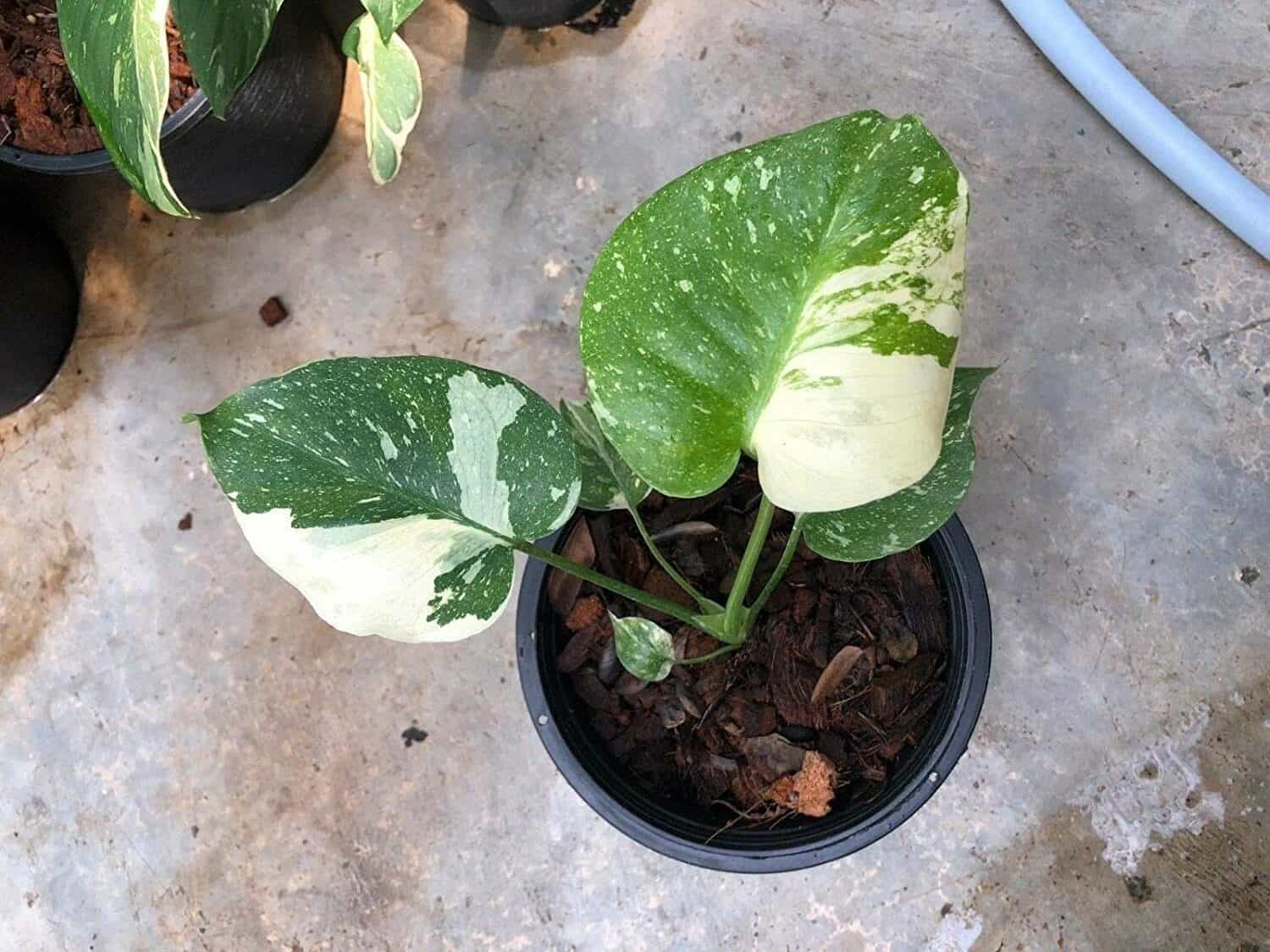
This is actually a variety of Monstera Deliciosa, but its leaves are variegated to make it look like a new type of Monstera plant. It is another unique-looking plant that is also easy to care for. These two qualities make it an excellent option to grow alongside a Watermelon Peperomia.
Light Requirements
Thai Constellation cannot handle direct sunlight for very long. It will grow best when placed in a spot that gets bright, but indirect or filtered sunlight. This plant can also grow under grow lights.
Soil Requirements
Thai Constellation grows best in peat-rich soil that is also well-draining. The soil should contain perlite and bark and maintain a pH level ranging between 5 and 7.5.
Water Requirements
It is always a good idea to check the moisture level of this plant’s soil before watering it. Only water it if the top two inches of soil is dry, otherwise, wait another day to try again. This plant needs at least 60% humidity in the air. This can be provided by spray bottles or humidifiers.
Pros
- It is very decorative
- It is easy to prune
Cons
- It is not drought tolerant
- It grows very slowly
- It is susceptible to root rot
- It requires stem cuttings that have nodes and leaves in order to propagate a new plant
- It is poisonous if the sap is touched or the plant is consumed
Bird’s Nest Fern
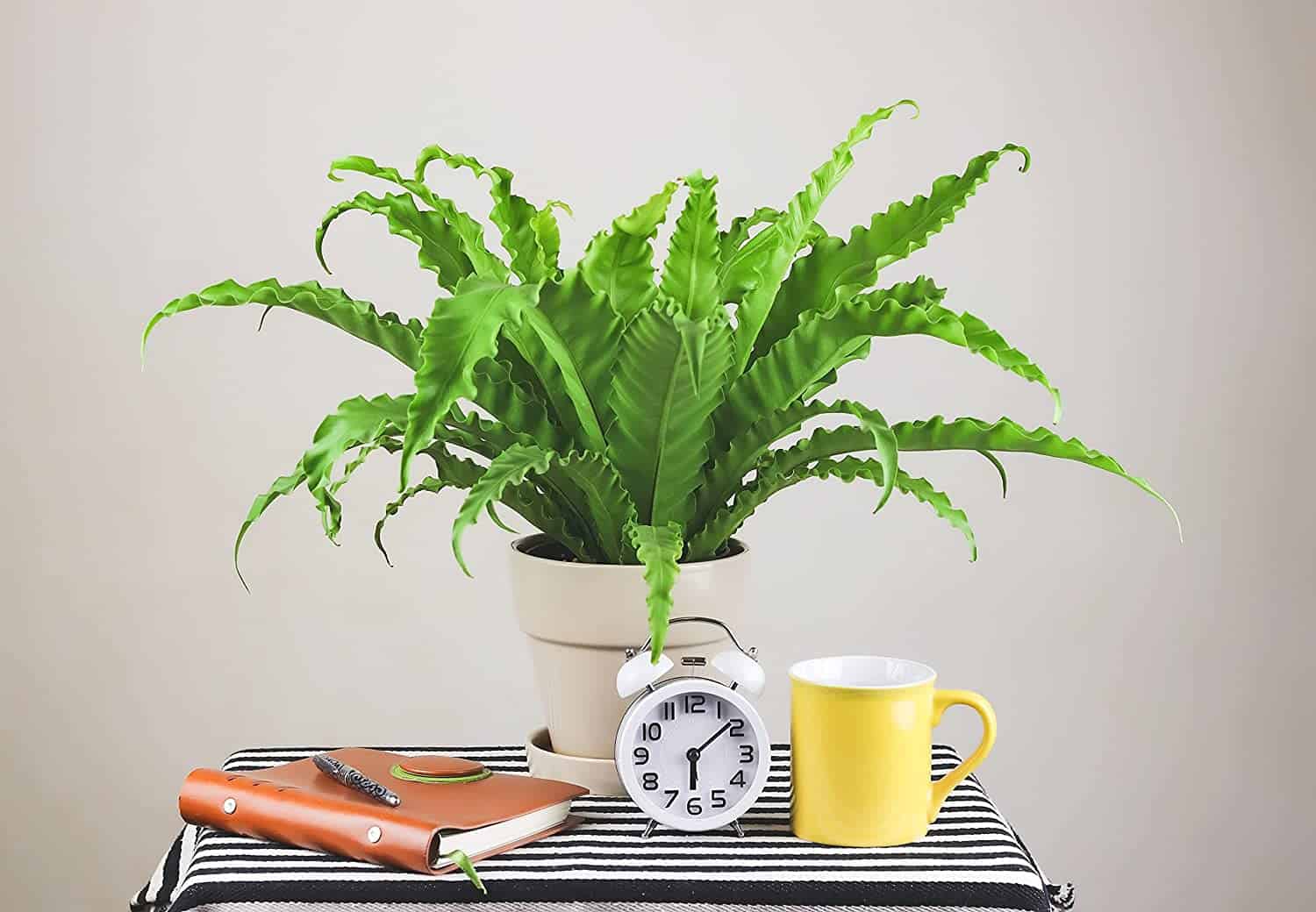
This is a moisture-loving tropical plant. It has crinkly green leaves and a hassle-free list of care requirements. This is an excellent option to set next to a Watermelon Peperomia.
Light Requirements
Bird’s Nest Fern should be set in a place that receives low to medium sunlight that is filtered or indirect. Its leaves are more crinkly with more light and flatter with less light.
Soil Requirements
Bird’s Nest Fern requires soil that drains well but holds some moisture. It should have pH levels that are acidic.
Water Requirements
Bird’s Nest Fern should only be watered when the top 25% of its soil is dry. It should be watered in the soak and dry method to avoid leaf rot.
Pros
- It is not toxic
- It has air-purifying qualities
Cons
- It is not cold tolerant
- It will dry out in direct sunlight
- It needs a humid environment
Watermelon Peperomia Diseases and Common Problems
This is a very hardy plant so it typically has few problems. Any problems it does face are easy to detect and deal with. The most common problems faced by Watermelon Peperomia are:
- Mealybugs
- Spider Mites
- Root Rot
- Yellowing Leaves
Watermelon Peperomia Treatments and Maintenance
The best way to care for a plant that is dealing with an infestation or a disease is to act quickly. This will give the plant a chance to survive and hopefully prevent nearby plants from getting infected as well. Here are the basic steps for dealing with the common problems faced by Watermelon Peperomia:
Mealybugs
Evidence of an infestation of mealybugs is small white spots that look like cotton on leaves and stems. To deal with an infestation of mealybugs, follow these steps:
- Spray a solution of alcohol and water on the leaves
- Rub the leaves with a cotton ball
- Coat the leaves in neem oil or insecticidal soap every few days
Spider mites
Evidence of a spider mite infestation will show up as webbing on the leaves and stems. Sometimes the tiny insects will even be visible crawling around the plant. To treat this type of infestation, fill a spray bottle with a quart of warm water, 1 tsp. of dish soap, and 2 tsps. Of neem oil. Use this mixture to spray and wipe the leaves and stems of the plant clean. It may be necessary to repeat this process several times to rid the plant of all the insects.
Root Rot
Evidence of this problem is leaves that have turned brown or black. To treat this problem, let the soil dry out completely and set the plant in a place where it will get plenty of airflow. If it is still struggling with too much water in its container, follow these steps:
- Remove the plant from its container
- Wash off all the dirt from its roots
- Cut off any roots that are rotten
- Replant the plant in a clean container with fresh soil
- Wait to water it for a few days
Yellowing Leaves
Figuring out what is causing the leaves of a Watermelon Peperomia to turn yellow will be a process of elimination. It could be caused by any of the following:
- Excessive sunlight
- Too little or too much water
- Nitrogen deficiency
Where to Buy Watermelon Peperomia Seeds Online
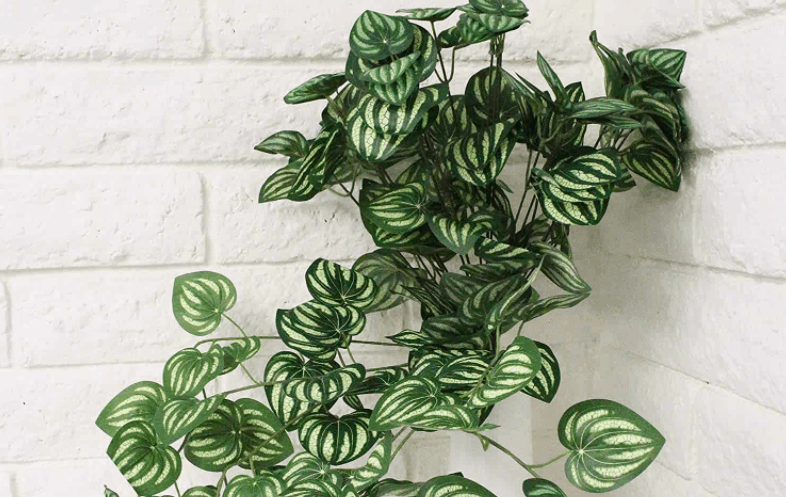
Look for Peperomia seeds at these online stores:
Where to Buy Mature Watermelon Peperomia Online
These plants can be purchased online at these shops:
FAQs
Question: Is Watermelon Peperomia Toxic?
Answer: No, this plant is not toxic.
Question: How Large Will Watermelon Peperomia Grow?
Answer: This is a small bushy plant that grows between 6 to 12 inches tall.
Question: Should Watermelon Peperomia be Pruned?
Answer: It is unlikely that this plant will require a lot of pruning (it grows slowly); however, if it has any stems or leaves that are dry, yellow, or just look unruly, they can be trimmed off. Also, pruning is an excellent opportunity to cut stems for propagating new Watermelon Peperomia plants.
Question: Does Watermelon Peperomia Produce Flowers?
Answer: Yes, but they are not flashy. The flowers that Watermelon Peperomia produces are small and green. They are unscented and are typically trimmed off the plant by most gardeners.
Concluding Thoughts
Watermelon Peperomia is a lovely little plant that is ideally designed for indoor spaces and outdoor gardens. Its unique-looking leaves are stunning and the plant itself is a real show-stopper. This is a plant that looks great anywhere and grows well for gardeners of every skill level. Simply put, it is beauty and simplicity wrapped up in one tiny tropical plant.

